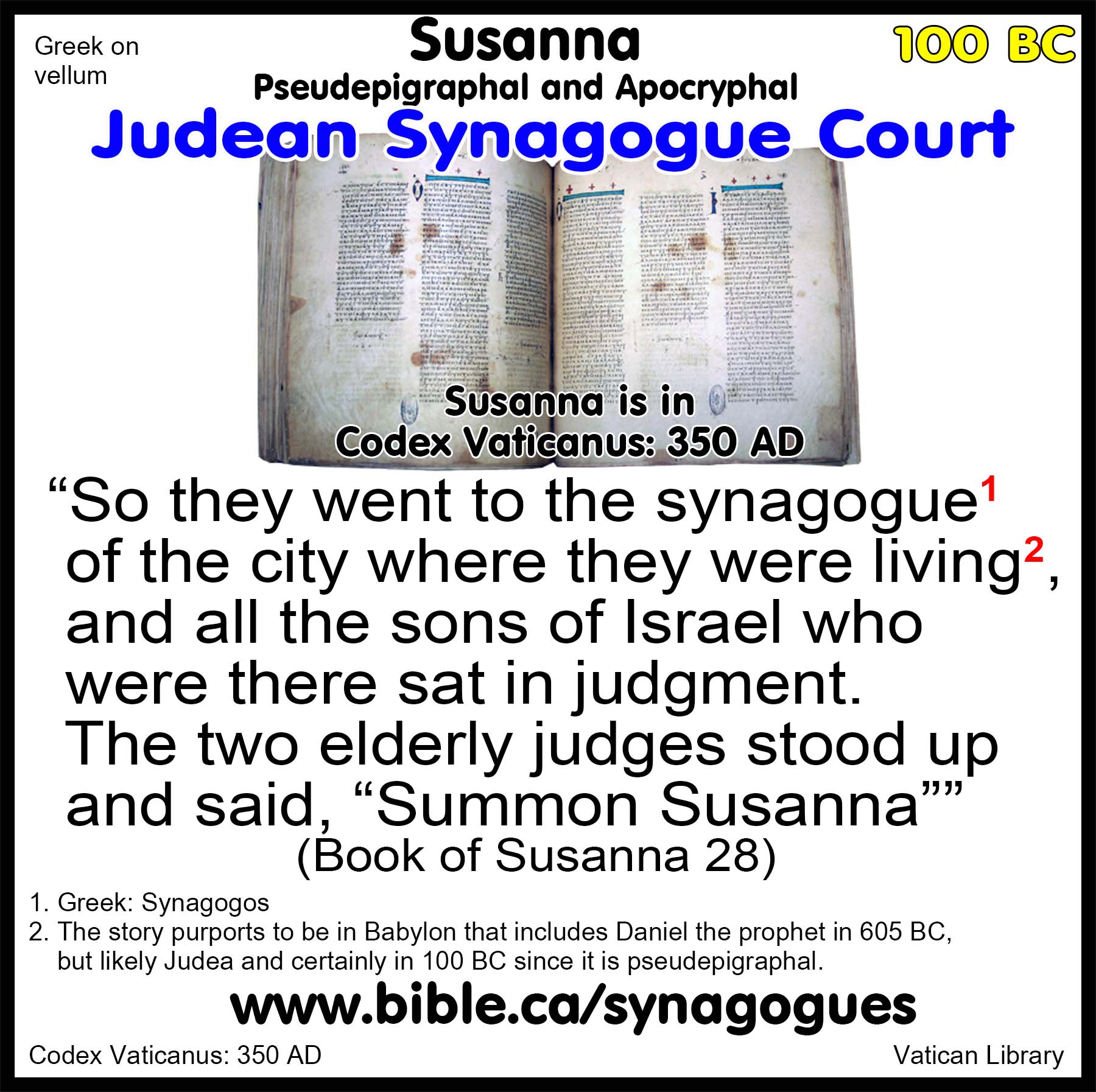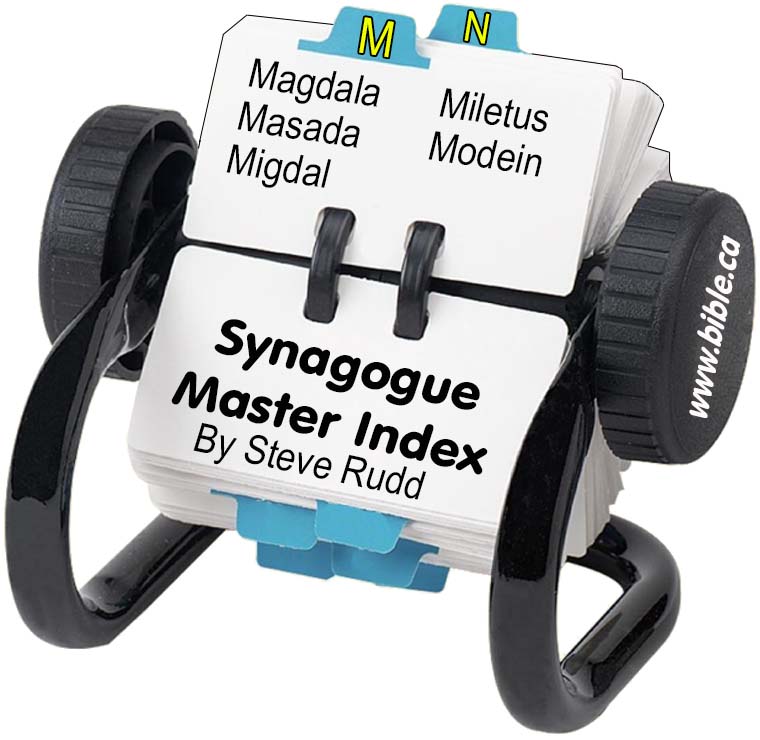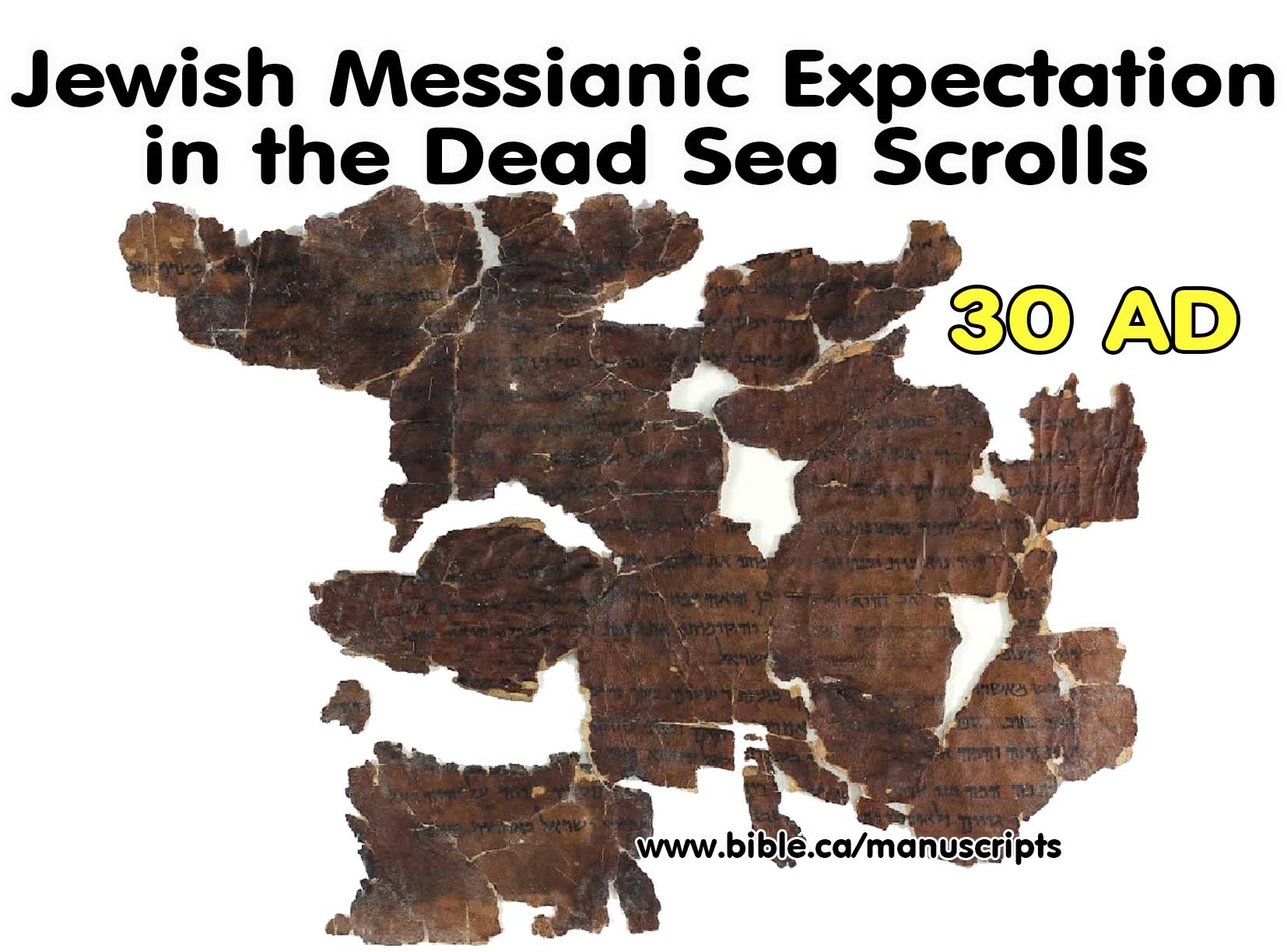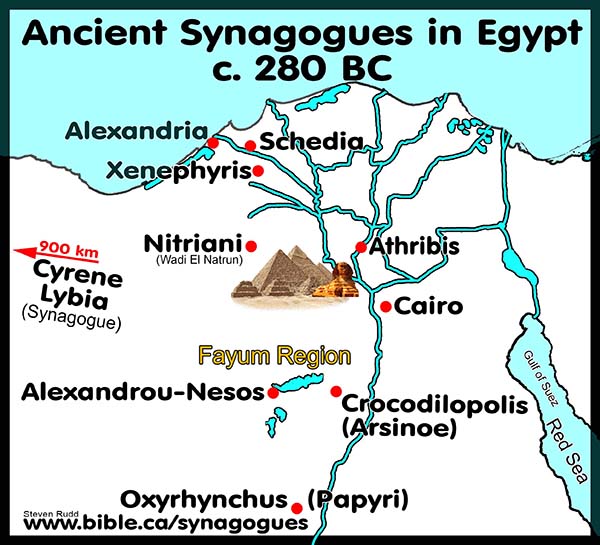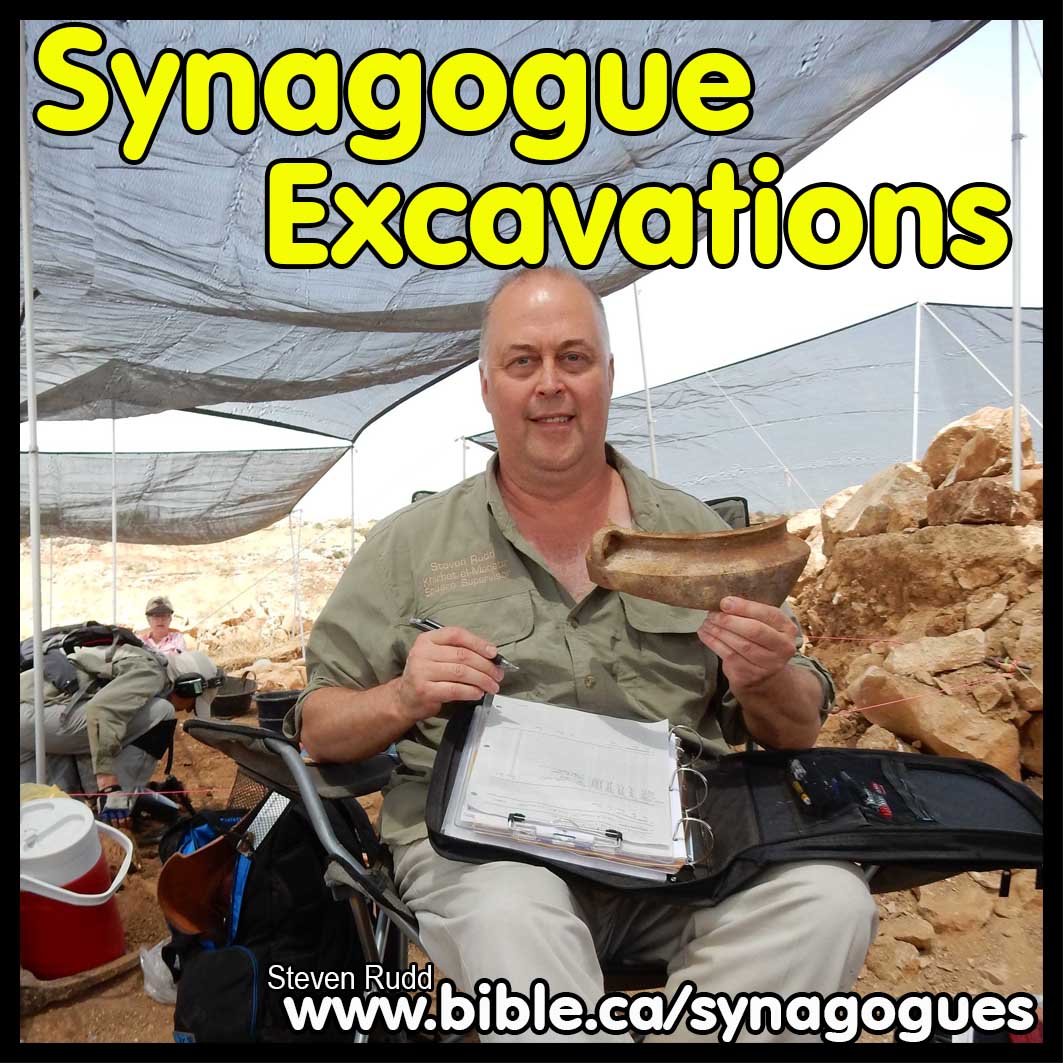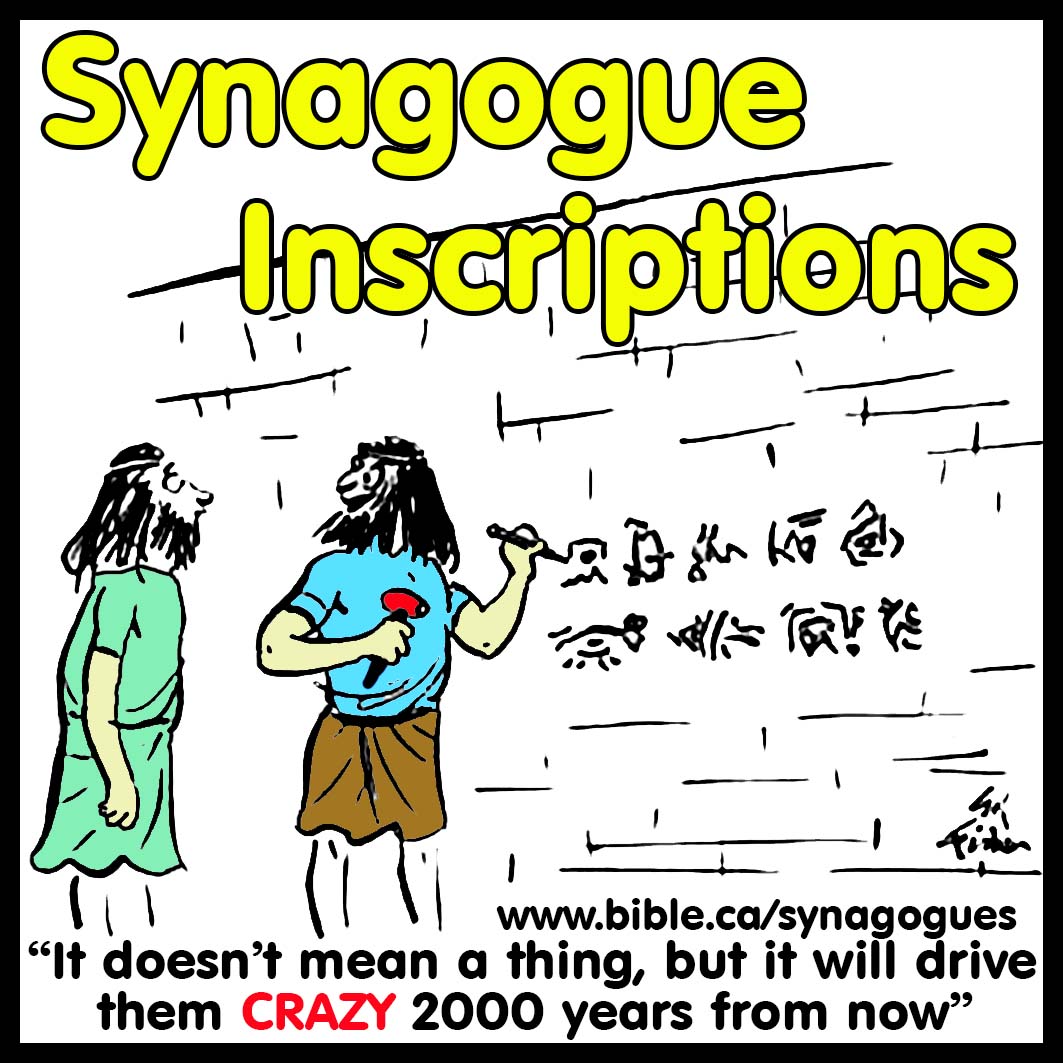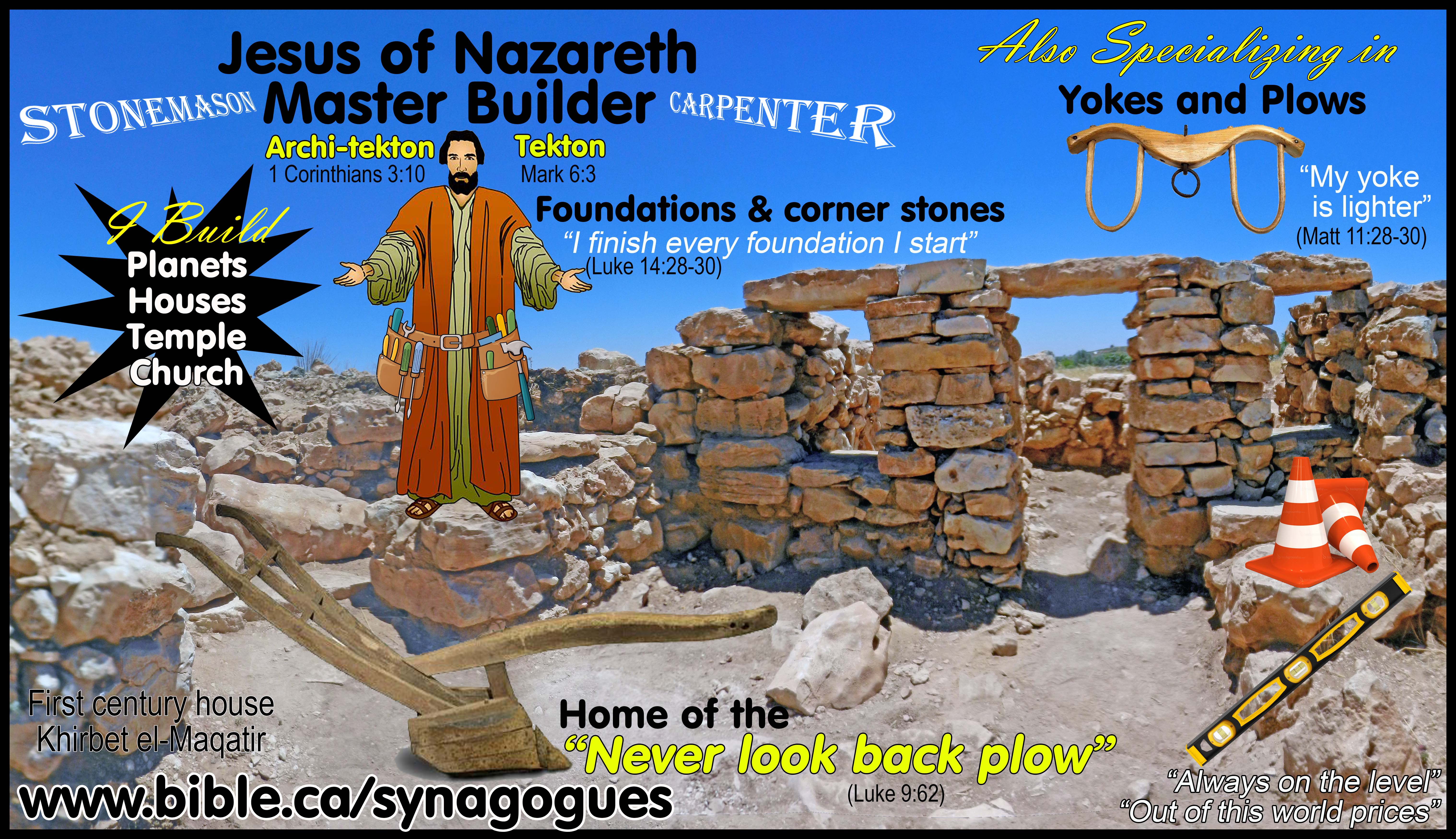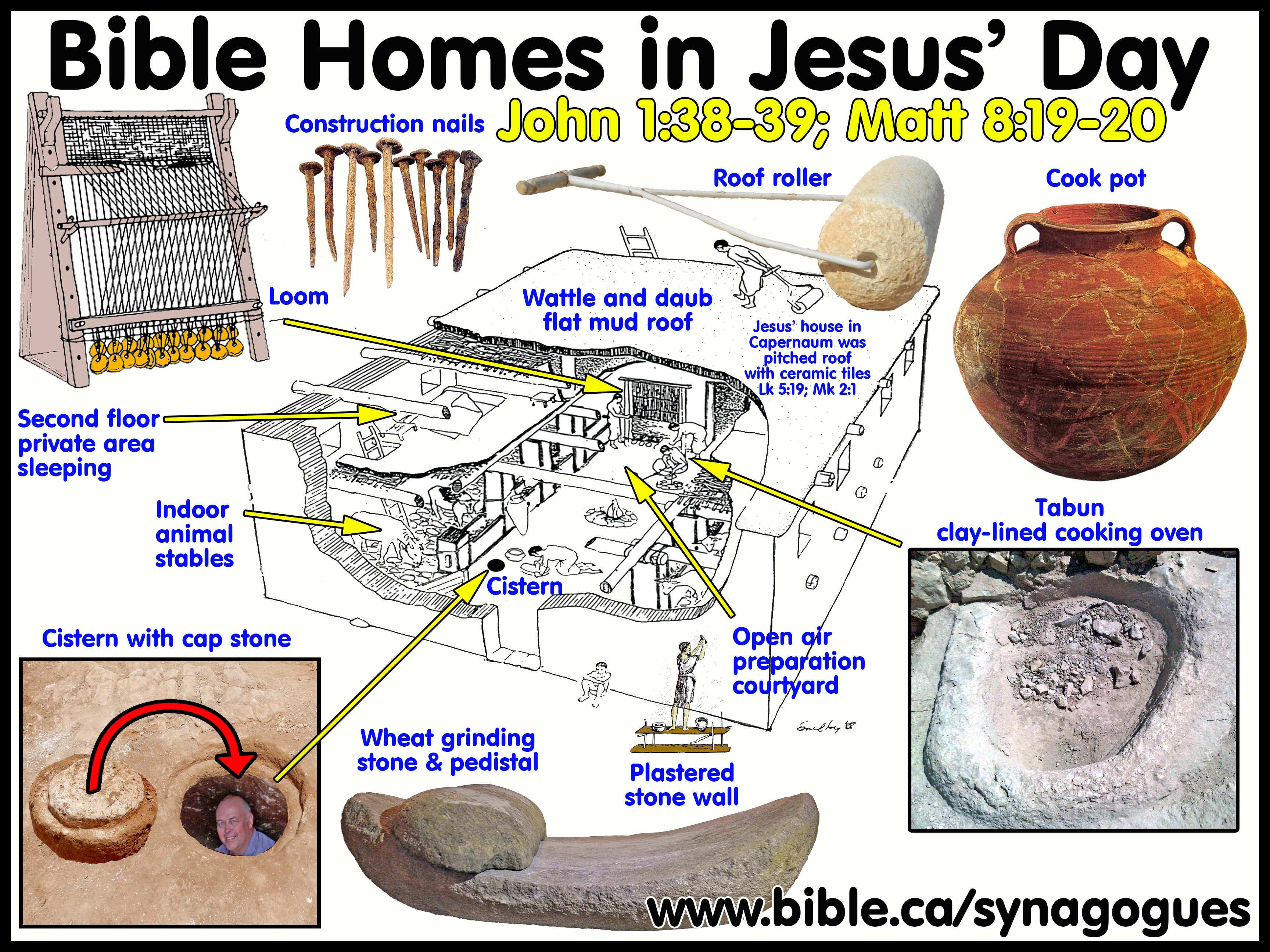Book of Susanna
Pseudepigraphal and Apocryphal
Ancient Synagogue Literary Sources
Susanna is contained in Codex Vaticanus: 350 AD
100 BC
So they went to the synagogue of the city where they were living, and all the sons of Israel who were there sat in judgment. The two elderly judges stood up and said, “Summon Susanna”” (Susanna 28)
Full text of Susanna:
"Now there was a man dwelling in Babylon, and his name was Jehoiakim. And he took a wife whose name was Susanna, the daughter of Chelkios, a very beautiful woman and one fearing the Lord. And her parents were righteous and taught their daughter by the Law of Moses. Now Jehoiakim was very rich, and he had a garden adjacent to his house, and they brought to him the Judeans, because he was more honored than all. Then two elders from the people were appointed as judges in that year, about which the Lord spoke, “Because lawlessness came from Babylon, from elder judges, who seemed to guide the people.” And judges would come from other cities to them. These saw a woman graceful in appearance, a wife of their kinsman among the sons of Israel, with the name of Susanna, daughter of Chelkios, wife of Jehoiakim, walking about in the garden of her husband during the evening. And longing for her, they perverted their mind and turned away their eyes so as not to look to heaven nor to keep in mind the administration of righteous judgments. Now both of them were enthralled about her, but each one did not indicate to the other the wicked feeling which possessed them concerning her, nor did the woman know about this situation. And when early morning came, they came in haste to see who would appear to her first and speak with her. And behold, this woman, according to her custom, was walking about. And one of the elders had arrived and behold, the other one arrived, and one interrogated the other one, saying, “Why have you, so early in the morning, come out without taking me along?” And each confessed to each other his grief. And one said to the other, “Let us go to her.” And when they had agreed they went to her and they forced her. Now the woman of Judah said to them, “I see that if I do this, then death it is for me. And if I do not do it, I am still not able to escape from your hands. It is better for me to not do this sin and so to fall into your hands than for me to sin before the Lord.” And the lawless men fled, terrified in themselves, and they were setting snares in order that they might kill her. And they came to the synagogue of the city where they were dwelling, and they were sitting and deliberating. The people there were all sons of Israel. And when the two elders had stood up, then the judges said, “Send for Susanna, the daughter of Chelkios, who is wife of Jehoiakim.” And they immediately summoned her. And when the woman was present, along with her father and mother and her servants and maidens, there were five hundred in number; also, the four young children of Susanna. And the woman was exceedingly refined. Then the wicked men commanded them to unveil her in order that they might be sated with her beauty, lusting after her. And all the people with her wept, and as many as knew her. And then the elders rose and the judges placed their hands upon her head. And her heart trusted in the Lord God, and lifting up her head to heaven she cried out within her, saying, “O Lord God, the everlasting one who knows all things before their beginning, you know that I have not done this. You know what these lawless ones maliciously intend to do against me.” And the Lord listened to her prayer. And then the two elders said, “We were walking about within the garden of her husband. And as we were going around the walkway, we saw this woman reclining with a man. And, while standing still there, we watched them having intercourse with each other. Now they themselves did not know that we were standing there. Then we talked to one another, saying, ‘Let us find out who these people are.’ Then when we stepped forward we recognized her, but the young man fled, veiled with a cloak. And seizing this woman, we asked her, ‘Who is the man?’ But she did not inform us about who he was with respect to these things which we witnessed.” And all the assembly believed them, since they were elders and judges of the people. Now behold, a messenger of the Lord. As that woman was being led out to be executed, the messenger gave, as he was commanded, a spirit of insight and understanding to a young man, Daniel. And Daniel, stirring up and dividing the gathering, and taking a stand in the midst of them, said, “In such a way as this, O foolish sons of Israel, are you not examining this closely nor recognizing the plain truth, that they killed a daughter of Israel? And now, separate out for me these men from one another by a great distance, in order that I can test them.” And when they were separated, Daniel said to the congregation, “Now, do not think because these men are elders, saying, ‘they would not lie,’ but I will examine them closely according to the things that fall under me.” And he summoned one of them, and they brought the elder to the young man. And Daniel said to him, “Hear, hear, you old relic of evil days, now your sins which you have committed in the past have come. As one entrusted to hear and to give just judgment in disputes, you have laid down the death penalty. And the innocent person you have condemned, but the guilty persons you are forgiving, while the Lord declares that the innocent person and the just person you will not slay. Now, therefore, under what tree and in what part of the garden did you see them present with each other?” And the ungodly man said, “Under the mastic tree.” And the young man said, “Very well, you have lied to your own soul; for the messenger of the Lord will tear apart your soul today.” Then, putting this man in another location, he said to bring forward to him the other man. Then to this man he said, “Why has your seed been perverted, as if stemming from Sidon, and not stemming from Judah? Beauty, a small lust, has seduced you. And so thus you treated the daughters of Israel, and they feared to be in company with you. But not a daughter of Judah consented to endure your disease in wickedness. Now, therefore, tell me under what tree and in what location of the garden you caught them having intercourse with each other?” And the man said, “Under the evergreen oak.” Then Daniel said, “O sinful man, now the messenger of the Lord has set it up, having a sword among the people. And he will utterly destroy you, in order that it may saw you asunder.” Then all the assembly cheered aloud for the young man, that out of each one’s mouth, with agreement between them, they established both of them as false witnesses. And as the law states clearly, so they did to them. Just as they had acted wickedly toward a kinswoman, so they gagged them and, after leading them away, they cast them into a ravine. Then the messenger of the Lord cast fire into the midst of them. And thus innocent blood was saved on that day. Because of this, the young men are beloved of Jacob in their integrity. And we indeed watch for able young sons who will live pious lives for young men. And there will be in them a spirit of understanding and knowledge and of insight and understanding unto age to age." (Susanna 1–62b)
Introduction:
1. With echoes of Bathsheba, Susanna is a young beautiful married woman who is seen by two old synagogue officials who desire her. Unlike Bathsheba, she refuses and they go to the synagogue court and falsely accuse her of adultery. In a full court setting witnesses are called and judgement is rendered with the stoning of the two lying synagogue officials.
2. This story, although fictitious, does prove that in 100 BC, synagogue buildings were used as civic courts.
3. The church borrowed this civic court function directly from the Jewish synagogue:
a. "Does any one of you, when he has a case against his neighbor, dare to go to law before the unrighteous and not before the saints? Or do you not know that the saints will judge the world? If the world is judged by you, are you not competent to constitute the smallest law courts? Do you not know that we will judge angels? How much more matters of this life? So if you have law courts dealing with matters of this life, do you appoint them as judges who are of no account in the church? I say this to your shame. Is it so, that there is not among you one wise man who will be able to decide between his brethren, but brother goes to law with brother, and that before unbelievers? Actually, then, it is already a defeat for you, that you have lawsuits with one another. Why not rather be wronged? Why not rather be defrauded? On the contrary, you yourselves wrong and defraud. You do this even to your brethren." (1 Corinthians 6:1–8)
A. Apocryphal Book of Susanna: 100 BC
1. The book of Susanna was a Greek Apocryphal addition to the Book of Daniel around 100 BC.
a. “Canonicity: The fact that the story occupied two different positions in the book of Daniel suggests that it was never fully integrated into that book, and this may explain why it was rejected from the Hebrew canon. Some scholars have also noted that the villains of the story were elders, a feature that would surely have been unpopular with the elders who fixed the canon.” (ISBE, Susanna, Vol 4, p669)
2. Date for Susanna: 100 BC
a. “The terminus ad quem is, as scholars from Bludau to Plöger all agree, the date of the Greek translation of the LXX of Daniel, which, while uncertain, was probably some time around 100 b.c. (see below). Scholars who follow Brüll’s thesis that “Susanna” was a Pharisaic polemic against Sadducean judicial theories and practices also date “Susanna” to the same general period.” (Daniel, Esther, and Jeremiah: the additions, C. A. Moore, p92, 2008)
3. Story line of Susanna:
a. “But the scoundrels turned, huddled together, and decided that they should have her condemned to death. So they went to the synagogue of the city where they were living, and all the sons of Israel who were there sat in judgment. The two elderly judges stood up and said, “Summon Susanna”. … “Go back to the place of trial; these men have framed her.” So all the people hurried back. Then the presiding elders said to him, “Come sit with us and inform us” … “Very good!” retorted Daniel to him, “you, too, have perjured yourself! The angel of God is waiting with drawn sword to hew you in half and destroy the pair of you!” Then all the congregation cheered”. (Susanna 28-29, 49-50, 59-60. LXX, 100 BC)
b. “Susanna is the [pseudepigraphal] story of Daniel’s [the Biblical prophet 605 BC] rescue of a young and beautiful woman, condemned to death for adultery as a consequence of a plot by two magistrates to blackmail her into having intercourse with them. The story opens with the marriage of Susanna to Joakim, in whose house the local court sits (vv. 1-6). Two of the elders or magistrates of the court desire Susanna and look for an opportunity to find her alone (vv. 7-14). As she takes a bath in her garden, they hide and then give her the choice of submitting to them or having them accuse her falsely of adultery (vv. 15-21). Susanna refuses their demands (vv. 22-23). She is accused, tried, and condemned to death (vv. 24-41). In response to her prayer for help, God sends the youth Daniel to aid her (vv. 42-46). He interrogates the two elders separately, proving their guilt, and the court sentences them to death in Susanna’s place (vv. 47-62). The story concludes with Susanna’s parents and husband praising God and the note that this case first established Daniel’s reputation among the Jewish people (vv. 63-64).” (Harper’s Bible Dictionary, Susanna)
B. Fully functioning “court-synagogue” in 100 BC:
1. All synagogues were also courts where judgements, trials and even scourging would take place as prescribed punishment with the both the criminals hand roped around the synagogue column.
2. Although the book falsely purports to be written in c. 600 BC, it still gives up the picture of the situation in 100 BC.
3. The synagogue is in a fixed, dedicated building.
4. The synagogue has formally recognized synagogue officials.
By Steve Rudd 2017: Contact the author for comments, input or corrections
|
Jesus your messiah is waiting for you to come home! |
|
|
Why not worship with a first century New Testament church near you, that has the same look and feel as the Jewish Synagogue in your own home town. As a Jew, you will find the transition as easy today as it was for the tens of thousands of your forefathers living in Jerusalem 2000 years ago when they believed in Jesus the Nazarene (the branch) as their messiah. It’s time to come home! |
|
By Steve Rudd: Contact the author for comments, input or corrections.
Go to: Main Ancient Synagogue Start Page
